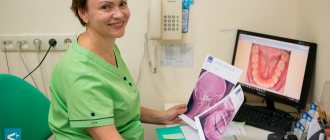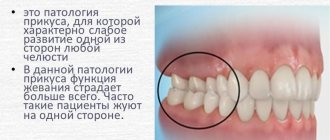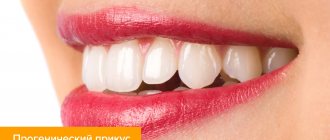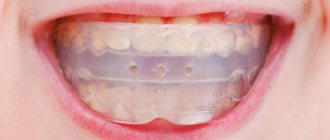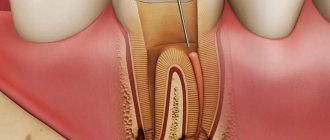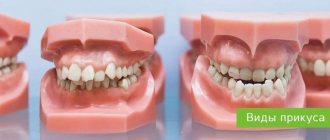Orthodontic dental treatment involves a range of dental services to correct the bite and eliminate related problems. In modern dentistry, this means not only installing braces and making trainers, but also, if necessary, surgical intervention.
One type or another of malocclusion can be diagnosed in most of the world's population. But for some people it causes especially many problems, from a feeling of psychological discomfort caused by uneven teeth, to health problems, for example, frequent diseases of the teeth and gums.
The goal of orthodontic treatment is to correct dental malocclusion.
Whatever method of teeth straightening you choose, you should remember that orthodontic treatment is always a very time-consuming process. Therefore, you need to start it with patience and prepare to wear an orthodontic appliance for a long time.
Methods for correcting bite
Today, dentistry uses two main methods: hardware and surgical. They are radically different and are prescribed for different indications. In addition, orthodontic treatment sometimes uses one combined method, as well as special functional therapy.
Hardware method
The hardware method, in simple terms, is a correction of the bite using removable or non-removable orthodontic structures of braces and plates. Many people have heard about this treatment. It is based on a mechanical effect on individual teeth or areas of the dental system, rebuilding bone tissue. Under mechanical pressure:
- individual teeth move;
- some malocclusions are corrected;
- the ratio of the dentition is normalized.
The orthodontist regulates the force of impact by changing the tension of rubber rods, wire arches, springs and special screws.
Surgical method
In case of pronounced deformation of the dental arches or disproportion of the jaws, the only possible option for correcting the situation will be a surgical method of treatment, an operation to change the shape of the jaw bones. Also, during surgery, you can turn the tooth around.
Hardware-surgical method
In some cases, the device is installed only after surgical preparation. As a rule, this is the removal of excess teeth to provide additional space in the dentition or trimming the frenulum of the tongue.
Functional method
This technique cannot be called completely orthodontic treatment, since it includes special gymnastics for the masticatory and facial muscles, general health measures, and strengthening the body’s natural strengths. Systematic exercises normalize muscle function, ensuring the harmonious development of the skeletal system.
In childhood, these measures have a good effect, allowing you to prevent abnormal development of the bite or completely get rid of it with the help of hardware treatment without relapses in the future.
Reduced chewing efficiency due to lack of a chewing band
Before
Stages
After
Specialists:
Denisova Ekaterina Alexandrovna
The main complaint in this clinical case was reduced chewing efficiency due to the absence of almost the entire chewing group of teeth in the lower jaw.
During the preparatory stage before orthodontic treatment, bridge structures on the upper jaw were removed. The abutment teeth are covered with single composite crowns fixed using an adhesive protocol. The goal of orthodontic treatment was to prepare the dental system for subsequent rational prosthetics, guaranteeing long-term stability of the result. Implantation of missing teeth was carried out at the stage of orthodontic treatment, just like temporary prosthetics. After the braces were removed, all temporary structures were replaced with permanent ones.
Stages of orthodontic treatment
- Diagnosis of malocclusions;
- X-ray examination of the jaw bones;
- selection of dental treatment methods and necessary orthodontic equipment;
- sanitation of the oral cavity, treatment of diseased teeth and gums, professional cleaning, etc.;
- installation of orthodontic apparatus;
- regular observation by a doctor, adjustment of the device;
- retention period to consolidate the achieved result;
- removal of orthodontic equipment.
Minor “troubles” after the procedure
After the doctor installs a removable device and adjusts it, the patient’s diction is impaired. Don't worry about this - it's completely normal. This occurs due to a decrease in the total volume of the oral cavity. After some time, the language will get used to it. It often takes him a couple of days to do this. To restore your diction, you can read a book out loud.
After the first installation of the device, low pressure is applied to the teeth. It goes away in just a few minutes. But if this does not happen and the patient complains of unpleasant sensations (cutting, pricking), the device must be removed. Only after this you need to get to the dentist as quickly as possible, who will correct the situation. If you delay the procedure, the relief of the mucous membrane will change, making it impossible to put the device back on. This will require ordering a new one and repeating the procedure.
The device must be looked after. It requires cleaning with a special paste at least twice a day. And this must be done with a separate brush. If you ignore this requirement, an unpleasant odor will soon come from your mouth. It is also important to store the device correctly. When dry, it must be placed in a special box. The dentist will give it to you.
Types of orthodontic structures
A lot of orthodontic devices have been developed, but they all belong to one of two large groups:
- removable;
- non-removable.
Removable structures
This group includes:
- mouth guards;
- vestibular plates;
- trainers.
Such structures are most often used in pediatric orthodontics to correct the bite of baby teeth.
Among adult patients, special mouthguards for correcting bites are very popular. But these designs are effective only for minor bite defects. Treatment with their help is expensive, time-consuming and useless for serious malocclusions. The choice of teeth straightening technology should be entrusted to a specialist. To do this, you need to sign up for a consultation at a serious dental clinic and certainly not engage in self-diagnosis and self-medication.
Fixed structures
They are mainly represented by fairly well-known bracket systems, of which there are several types, differing in materials and design. Materials used for the production of braces:
- metal;
- ceramics;
- plastic;
- sapphires;
- gold.
Some models of braces are located on the outer side of the dentition, they are called vestibular, others on the inner side, on the side of the tongue, lingual.
INVISALIGN mouth guards
Paris
Michel Cassagne: specialist from France.
Orthodontist
Our orthodontist, Dr. Michel Cassagne, was one of the first orthodontists to use Invisalign. He has the most experience with them and appreciates their effectiveness and practicality.
Aligners and trays for moving teeth are the most advanced technology in orthodontics.
- Mouth guards are an innovative technology in orthodontics
- Completely invisible to others
- Absolutely comfortable to wear
- Easy to care for and maintain hygiene
- No restrictions on food
Choice of orthodontic treatment
Since there are so many orthodontic treatment options, there are many to choose from. However, this is not easy to do; you need to take into account a lot of indications and contraindications. A specialist should deal with this issue; the patient has the opportunity to express his preferences. But the final word should remain with the doctor.
- When correcting a child’s bite, removable structures are a very good option. A child's jaw is very pliable; it reacts even to minor mechanical influences of a short duration. Therefore, convenient removable structures can cope with malocclusion development;
- removable orthodontic aligners are an option for correcting minor bite defects. But the defect must be really insignificant, otherwise the mouth guards will be a waste of money. The decision should be left to the dentist;
- To correct a more or less formed bite, braces are the best option. Here the patient has a wide scope; he can choose the materials and type of construction himself. But some restrictions are still present. Despite their high aesthetics, lingual braces are not able to eliminate all dental defects. Sapphire and ceramic systems are fragile and therefore are not very effective against serious anomalies. The opinion of the attending physician when choosing a brace system should remain decisive;
- When correcting serious malocclusions, there are few treatment options. Most often this is a surgical intervention, supplemented by the subsequent wearing of braces;
- For children, functional methods are recommended to prevent malocclusions, as well as correct minor defects.
What is orthodontics?
Orthodontics is one of the areas in dentistry. Doctors who work in this direction are called orthodontists.
Orthodontic treatment is aimed at diagnosing, preventing and treating dental anomalies. After completing a full course of treatment from a specialist, a person will be able to get rid of developmental defects of dental anomalies and get a perfect smile. After treatment, a person will no longer feel headaches after eating, and pain in the neck and back will go away. Thus, the treatment will affect not only the dentition, but also the entire body.
From the experts
In addition to all the above recommendations, experienced orthodontists offer a number of tips based on practical observations:
- For adults, before installing braces, it is better to remove their wisdom teeth, even if they have not yet erupted, since there is a high risk of them being damaged by caries;
- When choosing a doctor, make sure that the examination is thorough. If the orthodontist suggests putting on braces right away, this is a bad sign. However, another recommendation indicates the low qualifications of the specialist - he suggests waiting to start treatment. Most likely, he does not understand how to solve your problem;
- it is very important to treat all teeth before correcting the bite; in addition, you must learn how to clean them correctly so that while wearing braces the enamel does not become caries;
- Soft tissue adjustments may be required before treatment. You should not be afraid of this; if the doctor suggested performing the procedure, then it is really necessary.
Skeptics believe that correcting a bite in adulthood is useless, and braces are only effective on children’s teeth. This is not a completely correct opinion, but in some ways they are right:
- more significant pressure has to be exerted on the teeth of an adult, which leads to painful sensations at the initial stage;
- some teeth have to be removed to make room for others;
- Bridges and crowns have to be removed during treatment, which also does not add pleasant moments to the procedure.
Prevention. Why visit an orthodontist?
Dental problems begin at an early age, when a child’s baby teeth just begin to emerge. And often they are problematic due to improper care. The child may develop caries or develop some kind of defect that will develop, but the parents will let it happen due to the fact that “baby teeth will fall out anyway.” But parents must remember that it is necessary to treat baby teeth, since the problem will develop in permanent teeth and bite. Therefore, it is important to properly care for your oral cavity from childhood.
A woman who is just pregnant must take proper care of her health. All food and drinks that the expectant mother consumes affect the development of the child, and it is especially important to constantly maintain the level of fluoride and calcium so that they are at a sufficient level.
